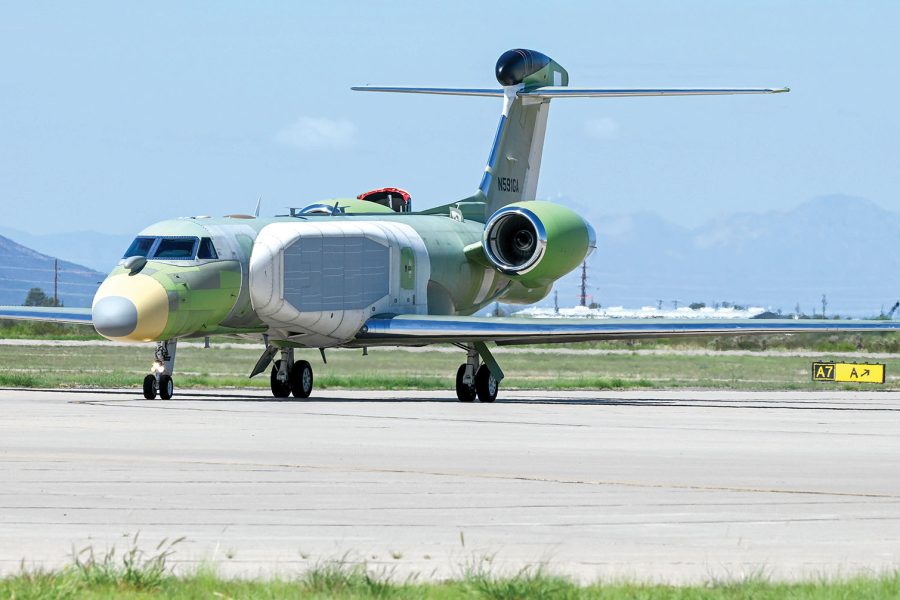Air Combat Command has redesignated the EC-37B electronic attack aircraft the EA-37B, effective immediately, the command announced last week. When the last EC-130 retires, the EA-37B will be the sole type to carry the name “Compass Call.”
The new designation better identifies the platform’s mission “of finding, attacking and destroying enemy land or sea targets,” an ACC release stated, as the aircraft will be primarily an electronic warfare or electronic attack system. The only other “EA” designation now flying is the Navy’s Electronic Attack EA-18G Growler tactical jamming aircraft.
The “C” designation was vestigial from the EC-130H and generally connotes an aircraft with a cargo mission.
The first of 10 EA-37Bs, heavily modified versions of the Gulfstream G550 airframe, was delivered to Air Force Materiel Command from BAE Systems and L3Harris for testing in September. After testing, the aircraft will go to the 55th Electronic Combat Group at Davis-Monthan Air Force Base, Ariz., for operational service sometime in 2024.
ACC has divested nine of its 14 EC-130H Compass Call aircraft, and when the last leaves the active inventory in 2026, the EA-37B will be the sole aircraft to use that name. The older aircraft are going into flyable storage at the 309th Aerospace Maintenance and Regeneration Group at Davis-Monthan, also known as the “Boneyard.”
“Flyable storage” means the EC-130s cannot be harvested for parts and could conceivably be returned to duty. Such designation usually means the aircraft are being held in reserve against the need to recall them in wartime.
“The EA-37B sustains Joint Force military advantage in electromagnetic battlespace and builds a more lethal force by modernizing electromagnetic attack capabilities to deny peer competitors’ tactical networks and information ecosystems,” ACC said in a release.
ACC commander Gen. Mark D. Kelly told reporters at AFA’s Air, Space & Cyber conference in September that the Air Force needs the EA-37B capability “yesterday,” due to China’s construction of a robust spectrum warfare capability in recent years. The Air Force’s only escort jammer aircraft—the EF-111A, an analogy to the EA-18—was retired without a direct replacement in the late 1990s.
Like the F-15EX, the EA-37B will undergo simultaneous developmental and operational testing, made possible by the fact that many of its systems are already being used on the EC-130H. Although the EA-37B was to make direct use of the hardware flying on EC-130s—the gear was to be physically ported from one aircraft to the other—ACC could not provide a detailed list of what specific items will carry over.
The EA-37B will inherit the EC-130Hs’ mission of jamming radars, communications and adversary electronic systems. It will also have other functions, playing a role in suppression of enemy air defenses (SEAD) by disrupting an enemy’s ability to coordinate command and control systems with sensors and surface-to-air radars and targeting systems.
“Most of what it does is highly classified,” Kelly told reporters at the conference. “Bottom line is, we needed to enable our ships and aircraft to get closer” to the enemy by providing electromagnetic cover for them, he said, while making it harder for enemy ships and aircraft to operate across the magnetic spectrum.
The operating concept for the EA-37B and EC-130H is similar, and those EC-130Hs not yet retired are being updated with new gear so they can “catch up with what will be on” the EA-37B, Kelly said.
The Gulfstream G550 business jets that form the basis for the EA-37B are manufactured in Savannah, Ga., and the aircraft are being modified with antennas and conformal arrays at L3Harris’ facilities in Waco, Texas.
Testing of the EA-37B is being done at Edwards Air Force Base, Calif. Kelly said the testing will focus on ensuring the EA-37B delivers very discrete effects.
“When we dial up the jamming power or ask for a specific waveform,” the signal generated by the EA-37B “needs to come out exactly” with the requested power and frequency, he said.
Testing will ensure “when you ask for a certain amount of jamming, that’s all you get. And when you turn it off, it turns off.”
The jet-powered EA-37B will be an improvement over the turboprop EC-130H in that it can fly almost twice as high and fast as the EC-130H, which is limited to a ceiling of 25,000 feet and a speed of 300 knots.
Th EA-37B will not become obsolete when the Air Force brings on Collaborative Combat Aircraft that can also perform electronic attack and electronic warfare missions, Kelly said, calling the two kinds of aircraft “complementary.” The EA-37B is designed not to inflict “electronic fratricide” on the F-15EX and F-35’s electronic warfare suites, he noted.

